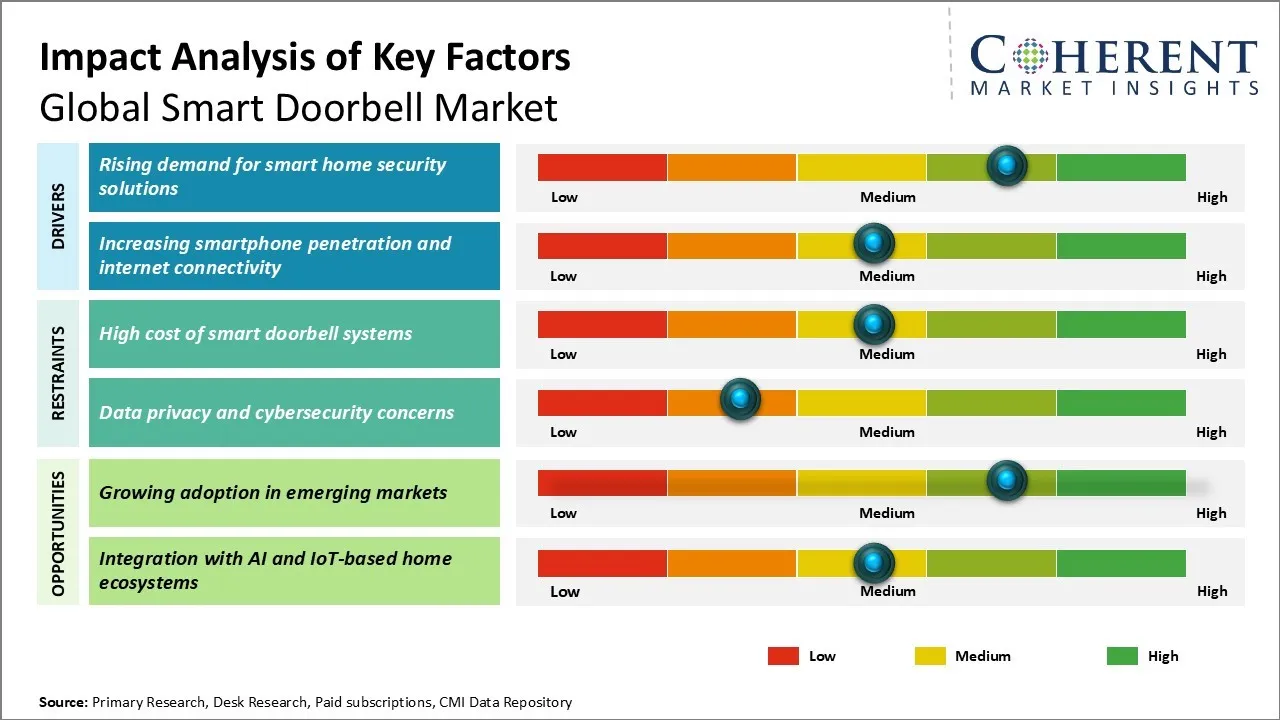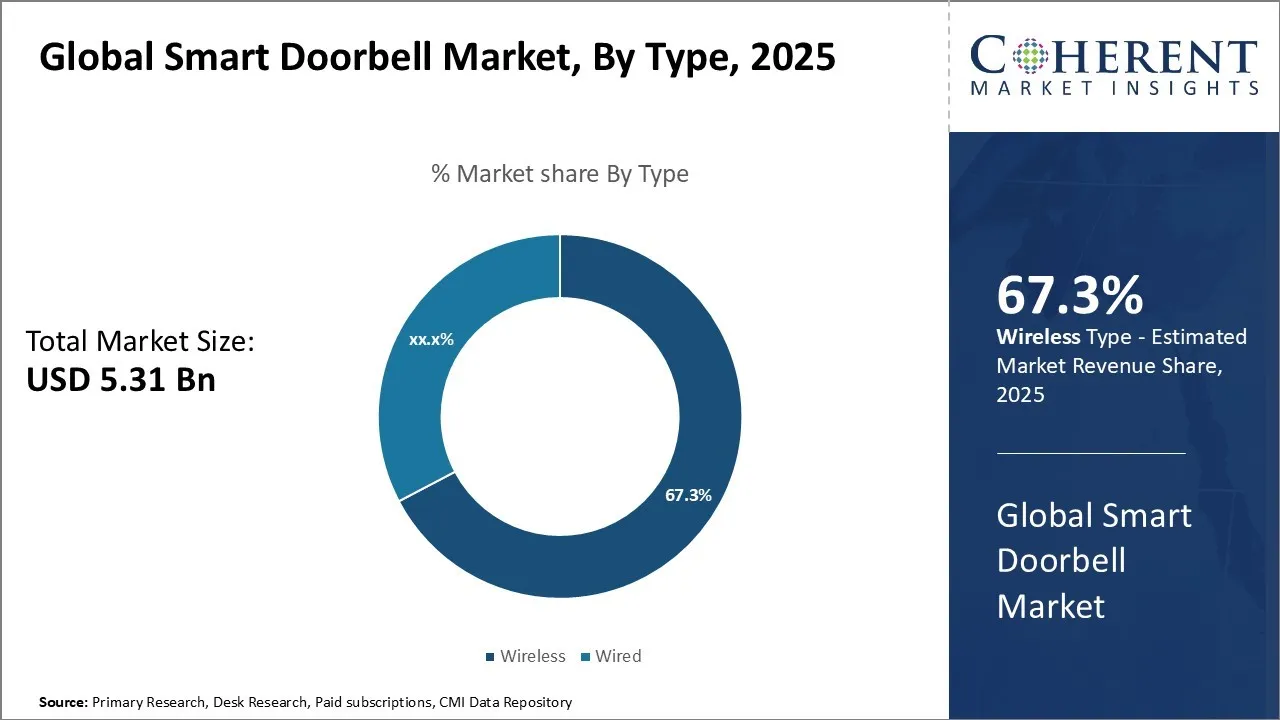Global Smart Doorbell Market Size and Forecast – 2025-2032
The Global Smart Doorbell Market is estimated to be valued at USD 5.31 Bn in 2025 and is expected to reach USD 16.03 Bn by 2032, exhibiting a compound annual growth rate (CAGR) of 17.1% from 2025 to 2032.
Key Takeaways of the Global Smart Doorbell Market:
- The wireless segment is expected to lead the market holding an estimated share of 67.3% in 2025.
- The Wi-Fi-based segment is projected to dominate with a share of 74.1% in 2025.
- North America is estimated to lead the market with a share of 41.8% in 2025. Asia Pacific, holding a share of 22.4% in 2025, is projected to be the fastest growing region.
Market Overview:
The smart doorbell market is experiencing significant growth due to the increasing demand for home security and convenience. The integration of advanced technologies such as artificial intelligence, facial recognition, and mobile connectivity has made smart doorbells more attractive to consumers. Also, the increasing adoption of smart home devices and the growing trend of home automation are expected to drive market growth in the coming years.
Current Events and their Impact
|
Current Events |
Description and its impact |
|
Geopolitical Tensions and Trade Policies |
|
|
Technological Advancements and Infrastructure |
|
Uncover macros and micros vetted on 75+ parameters: Get instant access to report
Global Smart Doorbell Market Insights, by Type - Wireless Segment Leads Due to its Convenience
The wireless segment of the global smart doorbell market is experiencing significant growth, holding a share of 67.3% in 2025. As consumers become more tech-savvy and seek ways to enhance their living experiences, they are turning to wireless smart doorbells as a convenient and secure solution. These devices offer seamless integration with existing smart home ecosystems, letting users monitor and control their home's entrances remotely through their smartphones or other connected devices.
The rising concern for home security is pushing consumers to opt for wireless smart doorbells. They often have advanced features such as high-definition video cameras, two-way audio communication, and motion detection. These features enable homeowners to see and communicate with visitors at their doorstep, even when they are not physically present.
Global Smart Doorbell Market Insights, by Technology - Wi-Fi-based doorbells lead due to their widespread availability and compatibility with existing home networks
The Wi-Fi-based segment of the global smart doorbell market is expected to hold the highest share of 74.1% in 2025. Most modern homes already have Wi-Fi infrastructure in place, which makes integrating a Wi-Fi-based smart doorbell easy. Also, Wi-Fi-based smart doorbells offer many advantages such as a stable and reliable connection, so that the doorbell remains connected and responsive even when there are fluctuations in the network.
To add to this, Wi-Fi-networks have high bandwidth capabilities, allowing Wi-Fi-based doorbells to transmit high-quality video and audio data. Thus, these doorbells give users a clear footage of their doorstep, and they can engage in smooth two-way communication with visitors. The introduction of newer Wi-Fi standards, such as Wi-Fi 6, is going to further improve these features, adding to the segment demand.
Pricing Analysis of the Smart Doorbell Market
|
Segment |
Average Price Range (USD) |
Target Market |
Key Features |
Representative Brands/Models |
|
High-End |
USD 180 – USD 350+ |
Premium residential users |
AI facial recognition, radar motion sensing, 4K/2K video, cloud + local storage, dual-band Wi-Fi |
Google Nest Doorbell (Wired), Ring Video Doorbell Pro 2, Arlo Video Doorbell 2K |
|
Mid-Range |
USD 100 – USD 179 |
General residential users |
2K HD video, AI motion/person detection, local storage, app integration |
Eufy Video Doorbell 2K, Ring Video Doorbell 4, Wyze Video Doorbell Pro |
|
Budget/Entry-Level |
USD 50 – USD 99 |
First-time and budget-conscious buyers |
720p–1080p video, basic motion alerts, night vision, wired/battery options |
RemoBell S, Blink Video Doorbell, Zmodo Greet Lite |
|
Commercial Solutions |
USD 300 – USD 500+ (bulk or multi-unit kits) |
Offices, multi-family units |
Enterprise-grade integration, remote access control, cloud admin tools |
August Home Intercom Solutions, Vivint Commercial Packages |
|
DIY/Niche Models |
USD 60 – USD 150 |
Renters, apartments |
Compact design, adhesive mounts, battery-only setup, voice assistant integration |
Remo+, Eken Smart Doorbell, TMEZON |
Uncover macros and micros vetted on 75+ parameters: Get instant access to report
Regional Insights

To learn more about this report, Download Free Sample
North America Smart Doorbell Market Analysis and Trends
North America, holding a share of 41.8% in 2025, is expected to dominate the global smart doorbell market. The region boasts a robust market ecosystem, with a high adoption rate of smart home technologies and a tech-savvy consumer base. The presence of major technology companies, such as Amazon, Google, and Ring (owned by Amazon), has significantly contributed to the growth of the smart doorbell market in North America. These companies have introduced innovative products and invested heavily in research and development, setting the standard for the industry.
Additionally, government policies and regulations in the region have been supportive of the adoption of smart home devices, including smart doorbells, which has further fueled market growth. The well-established trade dynamics and strong distribution networks in North America have also played a crucial role in the region's dominance.
Asia Pacific Smart Doorbell Market Analysis and Trends
The Asia Pacific region, holding a share of 22.4% in 2025, is expected to exhibit the fastest growth in the global smart doorbell market. The rapid urbanization, increasing disposable incomes, and growing awareness about smart home technologies have been the primary drivers of market growth in this region. Countries like China, Japan, and South Korea have witnessed a significant uptake of smart doorbells, thanks to their tech-savvy populations and the increasing demand for enhanced home security solutions.
The presence of local manufacturers, such as Panasonic and Xiaomi, and the entry of global players into the Asia Pacific smart doorbell market have further intensified competition and innovation in the region. Moreover, the expanding e-commerce industry and the increasing number of smartphone users in the region have created a conducive environment for the growth of the smart doorbell market.
Global Smart Doorbell Market Outlook for Key Countries:
U.S. Smart Doorbell Market Analysis and Trends
The U.S. smart doorbell market is highly advanced and mature, with a wide range of products available from both established and emerging players. The country's strong emphasis on home security, coupled with the high adoption rate of smart home devices, has driven the growth of the smart doorbell market. Major companies like Ring, Google Nest, and August have a significant presence in the U.S. smart doorbell market, offering feature-rich and user-friendly smart doorbell solutions. The integration of artificial intelligence, facial recognition, and cloud storage capabilities has further enhanced the appeal of smart doorbells in the country.
China Smart Doorbell Market Analysis and Trends
China smart doorbell market is rapidly evolving, driven by the country's massive consumer base and increasing disposable incomes. The growing awareness about smart home technologies and the desire for enhanced home security have fueled the demand for smart doorbells in China. Local manufacturers, such as Xiaomi and Hikvision, have introduced affordable and feature-packed smart doorbell options, catering to the diverse needs of the Chinese consumers. Additionally, the government's push towards smart city development and the adoption of IoT technologies has created a favorable environment for the growth of the smart doorbell market in China.
Japan Smart Doorbell Market Analysis and Trends
Japan continues to be a leader in the adoption of advanced technologies, and the smart doorbell market is no exception. The country's tech-savvy population and the increasing demand for convenience and security have driven the growth of the smart doorbell market in Japan. Companies like Panasonic and Sony have introduced innovative smart doorbell solutions that integrate with other smart home devices, offering a seamless and connected experience to users. The aging population in Japan has also contributed to the demand for smart doorbells, as they provide a convenient way to monitor and communicate with visitors remotely.
U.K. Smart Doorbell Market Analysis and Trends
The U.K. smart doorbell market is witnessing significant growth, driven by the increasing awareness about home security and the adoption of smart home technologies. Major players like Ring and Google Nest have a strong presence in the U.K. smart doorbell market, offering a range of smart doorbell products that cater to the needs of British consumers. The country's well-developed e-commerce industry and the increasing number of online purchases have further fueled the demand for smart doorbells, as they provide a secure way to receive and manage deliveries.
Market Players, Key Development, and Competitive Intelligence

To learn more about this report, Download Free Sample
Key Developments:
- In March 2025, Ajax Systems, a manufacturer of security systems, released Ajax DoorBell, with built-in AI, IR sensor, and app control.
- In March 2024, Ring, a subsidiary of Amazon (a tech giant), made its Ring Battery Video Doorbell Pro available for purchase. It is equipped with 1536p Head-to-Toe HD+ Video with enhanced sensors that deliver superior clarity and color.
- In October 2024, smart home control and automation manufacturer, Nice, launched its new Nice Video Doorbell offering integrators and homeowners an easy-to-install and use video doorbell that integrates with the Nice Home Management platform.
- In September 2023, Arlo Technologies, Inc., a smart home security brand, announced its second-generation Essential cameras and doorbells that deliver smart home protection. This launch included a Video Doorbell with head-to-toe 180-degree field of view.
Top Strategies Followed by Global Smart Doorbell Market Players
- Established players are investing heavily in R&D to develop advanced features such as facial recognition, motion detection, and AI-powered analytics.
- Google Nest has invested significantly in AI capabilities, including facial recognition, package detection, and radar-based motion sensing in its Nest Doorbell (Battery) and Nest Hello models. Nest uses Google’s machine learning to identify familiar faces and provide event-specific alerts.
- Mid-level players are focusing on delivering cost-effective solutions to target price-sensitive consumers by optimizing their production processes and leveraging economies of scale.
- Eufy offers high-quality smart doorbells with no mandatory subscription fees, appealing to cost-conscious consumers.
- Small-scale players are focusing on developing unique features or innovative products that cater to specific market segments.
- Remo+ targets niche segments by creating compact, battery-operated doorbells like the RemoBell S that integrate with a broader ecosystem of entry-level smart security products. It appeals to apartment dwellers or users who need easy DIY installation and compatibility with voice assistants without a large financial outlay.
Market Report Scope
Smart Doorbell Market Report Coverage
| Report Coverage | Details | ||
|---|---|---|---|
| Base Year: | 2024 | Market Size in 2025: | USD 5.31 Bn |
| Historical Data for: | 2020 To 2024 | Forecast Period: | 2025 To 2032 |
| Forecast Period 2025 to 2032 CAGR: | 17.1% | 2032 Value Projection: | USD 16.03 Bn |
| Geographies covered: |
|
||
| Segments covered: |
|
||
| Companies covered: |
Amazon (Ring), Google (Nest), Arlo Technologies, SkyBell Technologies, Vivint Smart Home, Xiaomi, ADT Inc., August Home Inc., Netatmo, Logitech, Remo+, Zmodo, Rohde & Schwarz, Bosch Security Systems, and Hikvision |
||
| Growth Drivers: |
|
||
| Restraints & Challenges: |
|
||
Uncover macros and micros vetted on 75+ parameters: Get instant access to report
Market Dynamics

To learn more about this report, Download Free Sample
Global Smart Doorbell Market Driver - Rising demand for smart home security solutions
The increasing adoption of smart home technologies and the growing need for enhanced security measures have significantly contributed to the rising demand for smart home security solutions. As homeowners become more aware of the potential threats to their properties and the importance of ensuring the safety of their families, they are increasingly turning to advanced security solutions like smart doorbells. These devices offer a range of features, such as real-time video streaming, two-way audio communication, motion detection, and integration with other smart home devices, providing users with a comprehensive and convenient way to monitor and control access to their homes.
The ability to remotely view and communicate with visitors, receive alerts when someone approaches the door, and deter potential intruders has made smart doorbells an attractive option for security-conscious consumers. Moreover, the seamless integration of smart doorbells with smartphones and other connected devices has further enhanced their appeal, driving the growth of the global smart doorbell market.
Amazon’s Ring has seen widespread adoption in the U.S., particularly in urban neighborhoods where package theft and doorstep intrusions are common. In response to consumer concerns, Ring introduced enhanced AI features like Package Detection, Motion Zones, and Live View with Real-Time Notifications, integrated through the Ring Protect Plan.
Global Smart Doorbell Market Opportunity - Growing Adoption in Emerging Markets
The global smart doorbell market is poised for significant growth opportunities in emerging markets, driven by increasing consumer awareness, rising disposable incomes, and the rapid adoption of smart home technology. Countries such as China, India, and Brazil present immense potential for smart doorbell manufacturers due to their large populations, expanding middle class, and growing emphasis on home security. Xiaomi launched the MIJIA Smart Doorbell 2 in India and Southeast Asia at a highly competitive price (USD 50), with features like 720p video, cloud storage, and app-based alerts.
Furthermore, the increasing penetration of high-speed internet and the proliferation of smartphones in these regions enable seamless integration of smart doorbells into connected home ecosystems. To capitalize on this opportunity, market players should focus on tailoring their products to the specific needs and preferences of consumers in emerging markets, such as offering localized language support and integrating with popular regional smart home platforms.
Analyst Opinion (Expert Opinion):
- AI has transformed smart doorbells from simple motion-activated cameras into intelligent, context-aware security systems. With AI-powered features like facial recognition, object detection, and behavioral analytics, modern doorbells now distinguish between people, pets, packages, and potential threats—dramatically reducing false alarms and increasing user trust. This shift is especially impactful in urban areas.
- Market leaders are pivoting toward subscription-based services (cloud storage, incident archiving, AI-enhanced analytics) to ensure long-term revenue. The industry can expect more freemium-to-premium transitions, with software value driving lifetime customer value.
- While North America and Europe continue to account for the bulk of value, volume growth is being fueled by Asia Pacific and Latin America. The smart doorbell is shifting from a luxury to a middle-class security essential, particularly in countries like India, China, and Brazil. Brands must tailor their offerings for local connectivity issues, app language, price sensitivities, and region-specific smart home ecosystems to succeed.
Market Segmentation
- Type Insights (Revenue, USD Bn, 2020 - 2032)
-
- Wireless
- Wired
- Technology Insights (Revenue, USD Bn, 2020 - 2032)
-
- Wi-Fi-based
- Bluetooth-based
- Z-Wave/Zigbee
- Others
- Regional Insights (Revenue, USD Bn, 2020 - 2032)
-
- North America
- U.S.
- Canada
- Latin America
- Brazil
- Argentina
- Mexico
- Rest of Latin America
- Europe
- Germany
- U.K.
- Spain
- France
- Italy
- Russia
- Rest of Europe
- Asia Pacific
- China
- India
- Japan
- Australia
- South Korea
- ASEAN
- Rest of Asia Pacific
- Middle East
- GCC Countries
- Israel
- Rest of Middle East
- Africa
- South Africa
- North Africa
- Central Africa
- North America
- Key Players Insights
-
- Amazon (Ring)
- Google (Nest)
- Arlo Technologies
- SkyBell Technologies
- Vivint Smart Home
- Xiaomi
- ADT Inc.
- August Home Inc.
- Netatmo
- Logitech
- Remo+
- Zmodo
- Rohde & Schwarz
- Bosch Security Systems
- Hikvision
Sources
Primary Research Interviews:
Stakeholders:
- Home Automation Integrators and Installers (e.g., Smart Home Specialists, Security Technicians)
- Smart Doorbell Manufacturers and OEMs (e.g., Ring, Arlo, Google Nest, Eufy)
- E-commerce and Retail Channel Managers (e.g., Amazon Smart Home, Best Buy IoT Division)
- Network Security Experts (focusing on consumer-grade surveillance systems)
- Urban Planners and Smart City Consultants
- IoT Platform Providers (e.g., edge AI developers, cloud service providers)
Databases:
- Global IoT Device Census
- UN-Habitat Smart Cities Database
- HomeTech Insights International
- OECD Urban Technology Index
Magazines:
- Smart Home Weekly
- Connected Living Magazine
- Security Today
- IoT World Magazine
Journals:
- Journal of Smart Home and Urban IoT Technologies
- International Journal of Consumer Electronics and IoT
- Sensors & Security Systems Journal
- Journal of Urban Digital Infrastructure
Newspapers:
- TechChronicle (Global)
- IoT Daily News
- The Smart Home Times (US)
- The Economic Herald (Asia-Pacific Edition)
Associations:
- Global Home Automation Alliance (GHAA)
- International Smart Cities Forum (ISCF)
- Consumer IoT Consortium (CIoTC)
- Home Security Manufacturers Association (HSMA)
- Global Smart Living Council (GSLC)
Public Domain Sources:
- U.S. Census Bureau
- EUROSTAT
- United Nations Economic Commission for Europe (UNECE)
- World Bank
- ResearchGate
Proprietary Elements:
- CMI Data Analytics Tool, Proprietary CMI Existing Repository of information for last 8 years
Share
Share
About Author
Raj Shah is a seasoned strategy professional with global experience, from strategy to on-the-ground operational improvements. In last 13 years, he has executed number consulting projects focused on consumer electronics, telecom and consumer-internet business leading multiple long-term engagements towards mobilizing and executing on break-through strategy - leading to tangible sales results. Raj is also acting as a strategy consultant for one of the leading online hyper local service providers in India, contributing to their growth through critical strategic decisions. Raj usually spends time after office in talking to the passionate entrepreneurs, regardless of their funding status.
Missing comfort of reading report in your local language? Find your preferred language :
Transform your Strategy with Exclusive Trending Reports :
Frequently Asked Questions
EXISTING CLIENTELE
Joining thousands of companies around the world committed to making the Excellent Business Solutions.
View All Our Clients


